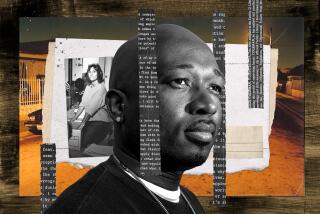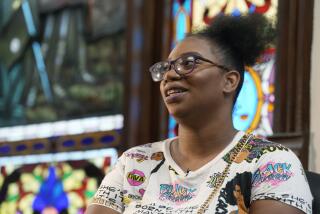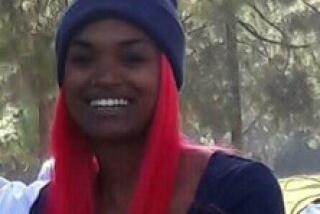COLUMN ONE : The Quiet After the Killing : Oliver Beasley’s death set off mass protest well before Rodney King’s beating. But furor fizzled, and deputies were cleared. What are the lessons?
A year before Rodney G. King, there was Oliver R. Beasley.
The 27-year-old Nation of Islam member, slain by Los Angeles County sheriff’s deputies after a traffic stop erupted into a melee, came to symbolize the brutality many blacks say they suffer at the hands of law enforcement.
His death provoked outrage, inspired protests and captured the attention of Muslim leader Louis Farrakhan--who labeled Beasley a martyr at his funeral, then called for an investigation of his “murder” before a crowd of 16,000 at a Sports Arena rally.
But as the case drifted from center stage into the more complex and cumbersome realm of the judicial system, the furor fizzled.
Without fanfare, the district attorney’s office cleared the two deputies of criminal wrongdoing. This month, a $15-million lawsuit brought by Beasley’s daughter ended quietly in Norwalk Superior Court with the officers exonerated by a unanimous verdict.
“It just sizzled out,” said Beasley’s mother, Doris.
Two years after his death became a rallying cry, the Beasley shooting demonstrates how even the most notorious cases of alleged brutality can slip into obscurity, relevant only to those most touched.
Black leaders, many of whom did not even know the matter had gone to trial, say it is a constant struggle in such cases to keep the spirit of protest alive. As time passes, passions subside, witnesses vanish and the slow grind of the legal system sours hopes for justice.
“This is unfortunately what happens,” said Brotherhood Crusade President Danny Bakewell, conceding that he was not aware of the case’s outcome. “That is what is so difficult. How do you keep the fire lit in order for the public outrage to continue?”
From the perspective of sheriff’s deputies, the incident offers a different lesson. In the heat of the moment, they say, conscientious officers are often subjected to wild accusations. Yet when their actions are vindicated, the headlines have disappeared.
“I saw the initial blowup as propaganda, something for the newspapers to report,” said Deputy David Dolson, who fired the shot that killed Beasley. “But people like that stuff. They like the meat. They like something that’s an outrage.”
Even when the legal system functions as designed, the underlying conflicts in such cases remain wrenchingly ambiguous and difficult to resolve.
Law enforcement sees these incidents as the unfortunate consequence of policing high-crime areas. Yet many blacks say authorities have used that explanation for centuries to justify the taking of life in their community.
Without a videotaped account to provide a documented view, allegations of police abuse are ultimately clashes of those competing realities--often fueled by beliefs that remain unshaken, regardless of the evidence at hand.
“It almost gets into a philosophical question of what is real,” said Halford H. Fairchild, a Los Angeles social psychologist who edits the journal of the Assn. of Black Psychologists. “Reality is very much dependent on the vantage point of the observer . . . and race is often a line of demarcation for how one defines reality.”
The death of Oliver Beasley is a study in those realities.
The man remembered by his family as a “halo kid” became front-page news on Jan. 23, 1990, in the 1100 block of West 106th Street--a slice of county land known as Athens, wedged between Inglewood and South-Central Los Angeles.
The address is home to a 20-unit apartment complex that was the headquarters for a Nation of Islam “God Squad,” a team of young Muslims who had come with a message of unity and pride, preaching strict dietary codes and self-defense skills as antidotes to drugs and violence.
That night, the talk was about Farrakhan, the inspirational and often controversial minister, who was scheduled to appear at the Sports Arena in 10 days. Beasley was with friends in Apartment 4, discussing their strategy for selling tickets, as well as the bean pies that are the organization’s signature product.
On a window facing the street, a poster advertised the theme of the rally. “Stop The Killing,” it said.
David Dolson, then a 24-year-old trainee with an almost cherubic face, was 1 1/2 hours into an overnight shift with his training officer, Deputy William Tackaberry, an imposing man with the look of a bulldog.
The officers, both assigned to the Lennox station, were cruising down 106th when they spotted the headlights of a car rapidly approaching in their rearview mirror. “This guy must be crazy,” thought Tackaberry, as he watched the car swerve into the next lane and swiftly pass.
Believing it might be stolen, the deputies hit their siren and flashing lights. But the driver--an 18-year-old Culver City high school senior named David Hartley--continued on for about a block, finally pulling into the apartment building’s carport.
“I didn’t do anything wrong,” Hartley later told sheriff’s investigators. “I don’t know why they stopped me.”
The commotion outside caught the attention of Beasley, a licensed welder and Air Force veteran. He was a second-degree black belt and dreamed of opening his own karate school, but spoke of first helping his brothers in the community break their self-destructive cycles.
“What’s the problem here?” asked one of the Muslims, who had gathered around the patrol car. Although all were dressed in the Nation’s trademark dark suits and bow ties, the deputies did not recognize them, figuring that the clean-cut youths had just returned from a school prom.
“No problem,” the officers said. “You guys can just wait inside.”
“No, sir,” responded the group of eight to 10. “He’s one of our soldiers.”
In retrospect, the deputies say, that should have been their clue that the situation was about to deteriorate.
Just three weeks earlier, a group of Muslims had clashed with Los Angeles police in the Crenshaw district after a traffic stop. The Muslims--who believe blacks will not find justice until they form a separate nation--say they are trained to be respectful of police, but will fight to the death if attacked.
“I figure now that their heads were so filled up with this rhetoric about how brutal we are . . . that maybe they thought we were going to do something horrible,” Dolson said.
What happened next is disputed, but there is no question the confrontation exploded in a volatile flash.
Deputies say Hartley started a struggle, then someone grabbed Dolson’s neck from behind.
“Let him go!” shouted Tackaberry, as he drew his 9-millimeter Beretta and twice clubbed his partner’s assailant in the head. As Dolson fell to the ground, “millions of hands” grabbed for his gun and stripped it from his grasp.
Certain he was about to die, Dolson looked away, unable to bear the sight of being shot with his own weapon.
With the chant of “Kill the Police, Kill the (expletive) Pigs” pounding in his head, Dolson reached for a second revolver in his rear pocket--a tiny Smith and Wesson--and fired four times into the crowd. Hartley was struck once in the back.
Dolson then turned his attention to his partner, who was locked in a frenzied battle with Beasley for control of the deputy’s gun. Both their hands clutched the semiautomatic pistol as the barrel waved wildly between them.
“Kill him,” Tackaberry pleaded with Dolson. “He’s got my gun! Kill him!”
Dolson pointed his backup gun several inches from Beasley’s head and fired his last bullet.
“I just wanted to make it out,” Dolson said. “I didn’t want to die that night.”
The entire incident lasted less than two minutes, but the scene remained under siege for hours, with sheriff’s helicopters circling above, a Special Weapons Team standing by and homicide investigators combing the ground.
The Nation of Islam also dispatched a crew to tape-record the accounts of witnesses and photograph bullet holes in the stucco walls around the building. But for them, there was a greater truth about the shooting, something beyond the evidence at the scene.
They saw it as another example of society’s oppression of blacks and, specifically, the negative perceptions of black neighborhoods that they say police invoke to justify the use of force.
“This is like being in South Africa,” said Alfred 3X, one of the Muslim investigators.
If Hartley did not pull his car over right away, they say, it was only because he feared being alone with two white policemen. If other Muslims rushed to his aid, it was only because they felt a duty to protect him. And if Beasley grabbed a deputy’s gun, they contend, it was only a last futile effort to save his own life.
“We do everything we can to bring about peace, but we have a God-given right to defend ourselves,” said Abdul Wazir Muhammad, Farrakhan’s western regional representative and minister of Mosque No. 27, which Beasley attended. “God didn’t draw no lines--he didn’t say, ‘If the police got guns, you don’t defend yourself.’ ”
The Sheriff’s Department moved to defuse the situation, but the community was already in an uproar.
Stories were circulating that deputies had beaten Beasley, handcuffed him and dragged him by his heels “up and down the street.” One version had him lying on his back pleading for his life when the fatal shot was fired. Another suggested that he had picked up the gun and was returning it to the officers when they killed him.
Farrakhan arrived at the Sports Arena to his largest Los Angeles crowd ever. Beasley’s picture, 15 feet tall, hung behind the dais and a banner proclaimed: “Long Live Brother Oliver X. Beasley.”
At Beasley’s funeral, Bakewell told 2,000 mourners: “We will not turn our heads and let this brother’s death go unaccounted for.”
But in the months that followed, anger was replaced by bitter reality.
Witnesses, after alleging so many atrocities, did not come forward. The Muslims explained that residents were fearful of retribution from sheriff’s deputies, whom they compared to “Hitler’s army.” But officials contended that it was because the witnesses had not been truthful in the first place or knew they would implicate themselves in the fracas.
Meanwhile, new, equally troubling allegations of brutality--including the videotaped beating of King--pushed the Beasley case from the limelight. Impassioned rhetoric gave way to the more rigorous nuts and bolts of the judicial system.
For many blacks, who never believed that the courts were designed to bring them justice, the deteriorating case was one more sign of their powerlessness. “It’s like the deck is stacked in a way that you know the outcome of the game,” Muhammad said.
The Beasley family, hoping to uncover evidence of abuse, hired an independent pathologist to attend the autopsy. But when the skin on his back was peeled away, doctors determined that Beasley had not been dragged, as some witnesses claimed right after the shooting.
Hartley, the only suspect the deputies could identify, was charged with attacking and disarming a police officer. But rather than challenge the official version of events, he agreed to a plea bargain and was given one year probation--undermining his credibility when he later testified on Beasley’s behalf.
As with most law enforcement shootings, the Beasley case led to a civil lawsuit, filed nine months after his death. Instead of recapturing the outrage, however, it sparked a family squabble.
The plaintiff was Beasley’s illegitimate daughter, Brittany, now 9, who had been conceived during a one-night stand. His family did not even know her and accused the girl’s mother of using the child to cash in on their grief.
To stake the family’s claim, Beasley’s mother, on her own behalf, also filed a lawsuit. But she came up empty-handed in her search for witnesses and for an attorney willing to take her case.
“My rejection of the case was by no means an endorsement of the shooting,” said police misconduct lawyer Johnnie L. Cochran Jr., who was consulted by Beasley’s mother. “I thought it was a tragedy . . . but my gut instinct told me it would be almost impossible to prevail.”
By the time Brittany’s lawsuit went to trial last December, 23 months had passed since Beasley’s death--and attitudes about police had changed dramatically.
In those two years, Los Angeles County had been hit with more than $20 million in court judgments, jury awards and settlements of lawsuits against the Sheriff’s Department. The King video had raised further questions about the credibility of official accounts in cases of alleged brutality.
“I only thought it was a matter of how much,” said Brittany’s attorney, Arden B. Silverman. The deputies’ attorney, Dennis M. Gonzales, principal deputy county counsel, conceded that he was facing an “uphill fight.”
But when they convened on the sixth floor of the Norwalk courthouse, there were no TV cameras, few spectators and little hoopla. Even the two deputies, expecting the harsh glare of the spotlight, were surprised to find that the case had fallen through the cracks.
At the last minute, the trial had been transferred to Norwalk from the busy Compton courthouse, which had no courtrooms available. Silverman objected, contending that the jury pool would include fewer blacks.
“I think people who live in the Compton area are more in tune with the fact that the police can, on occasion, act beyond their scope,” he said. “They have a greater sense of reality of what may happen.”
Once the trial began, Silverman contended that the deputies, hard-nosed and weapons drawn, were responsible for escalating a traffic stop into a life-and-death struggle. Gonzales, who believes the Muslims sparked the confrontation to win publicity for Farrakhan’s visit, argued that a hostile group forced the officers to take drastic action.
Only two eyewitnesses, including Hartley, testified on Beasley’s behalf. Both said he was shot while lying on his back--despite evidence that the bullet entered the back of his head and traveled forward. The deputies stuck to their story, painfully averting their eyes at the sight of Beasley’s family.
“You just never know if somebody is going to be able to understand what you knew and felt that night,” Dolson said.
The jury--which included six minorities, but only one black--listened to 3 1/2 weeks of testimony, then on Jan. 7, reached a verdict in less than two hours.
Several jurors said they were uncomfortable with the high price Beasley paid for his actions and acknowledged that they might have thought differently had more witnesses come forward. But, given what they were told, they all agreed that the officers had been left no choice.
“There may have been something we don’t know about, or whatever, but what we knew about, there was no other way,” said juror Mary Stowell, 66, of Santa Fe Springs. “I’m sure there are bad policemen, but in this particular case, we didn’t find any evidence of that.”
Though its final chapter is over, the Beasley case lacks a conclusion.
The system designed to resolve the allegations functioned properly, but few ended up satisfied with the way it worked. Bitterness and suspicion linger.
Sheriff’s officials worry about the damage done to the reputations of two officers. “A couple of fine young men have gone through hell,” as Capt. Doug McClure, a Sheriff’s Department spokesman, put it.
In the black community, where word of the verdict is slowly beginning to circulate, leaders say their instincts, steeped in a history of injustice, tell a different story.
The Rev. Cecil L. Murray, whose First African Methodist Episcopal Church was the site of Beasley’s funeral, conceded that he does not know all the facts of the case. But he added: “In my heart, I know unerringly what occurred.”
Deputies Dolson and Tackaberry are still assigned to the Lennox station. Neither has been haunted by the incident, although Dolson acknowledges a twinge of queasiness when he replays the shooting in his head. “It gave me an appreciation for my life, definitely,” he said. “My life is precious too.”
Doris Beasley, who suffered a stroke several months after her son’s death, still lives in the family home, a stucco bungalow near Gardena purchased in 1956.
Oliver, the youngest of her six children, was the one she least fretted about.
“If he did this--and I can’t say he didn’t because I didn’t see it--it certainly wasn’t his lifestyle,” his mother said. “That’s not who he was. That’s not what he was about. That wasn’t Oliver.”
In the end, the one undisputed truth of the Beasley case may be just that he is dead, buried in an Inglewood cemetery under a small grave marker with roses etched in the gray marble. “We love you,” reads the inscription, “but God loves you more.”
More to Read
Sign up for Essential California
The most important California stories and recommendations in your inbox every morning.
You may occasionally receive promotional content from the Los Angeles Times.









